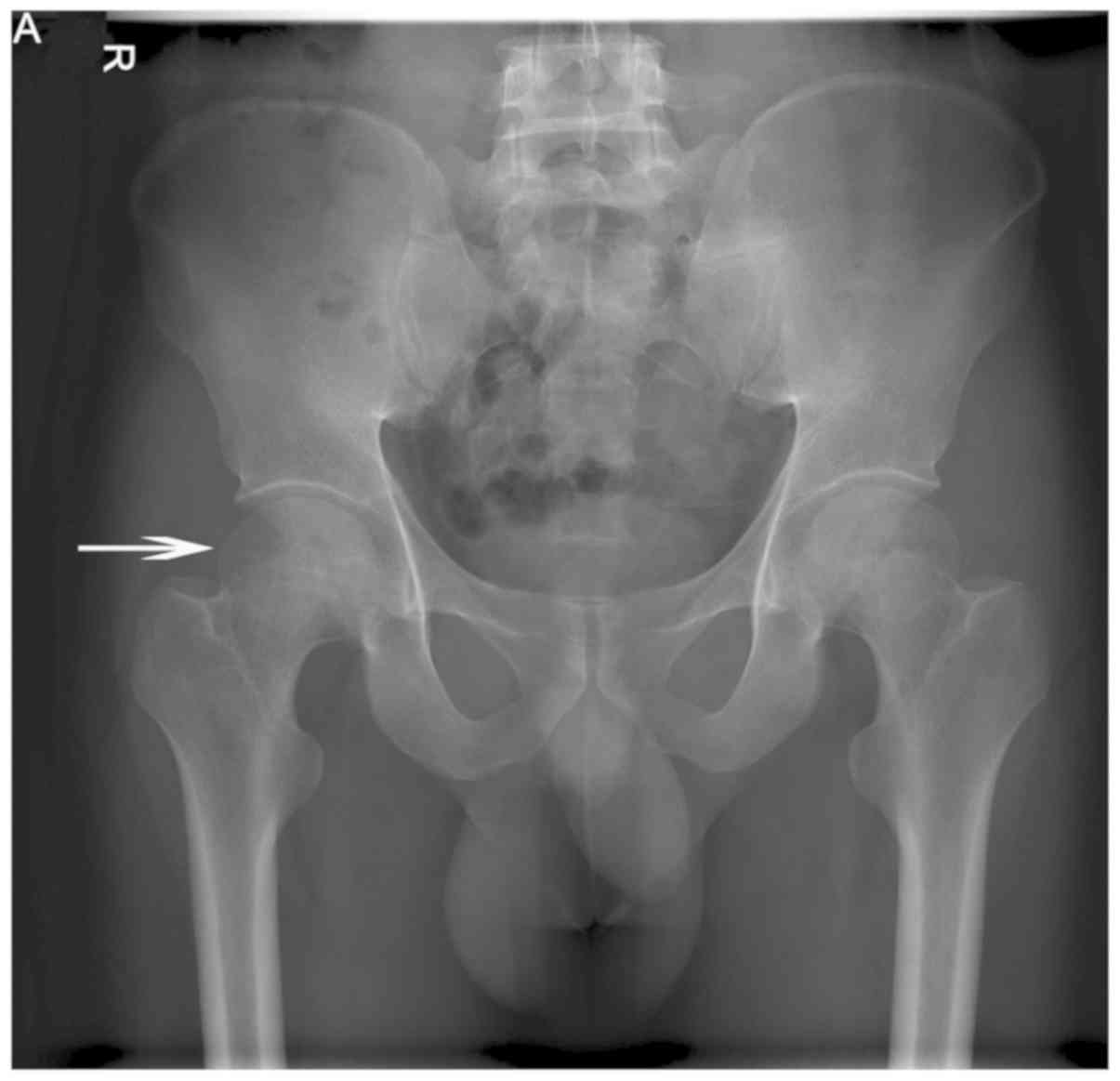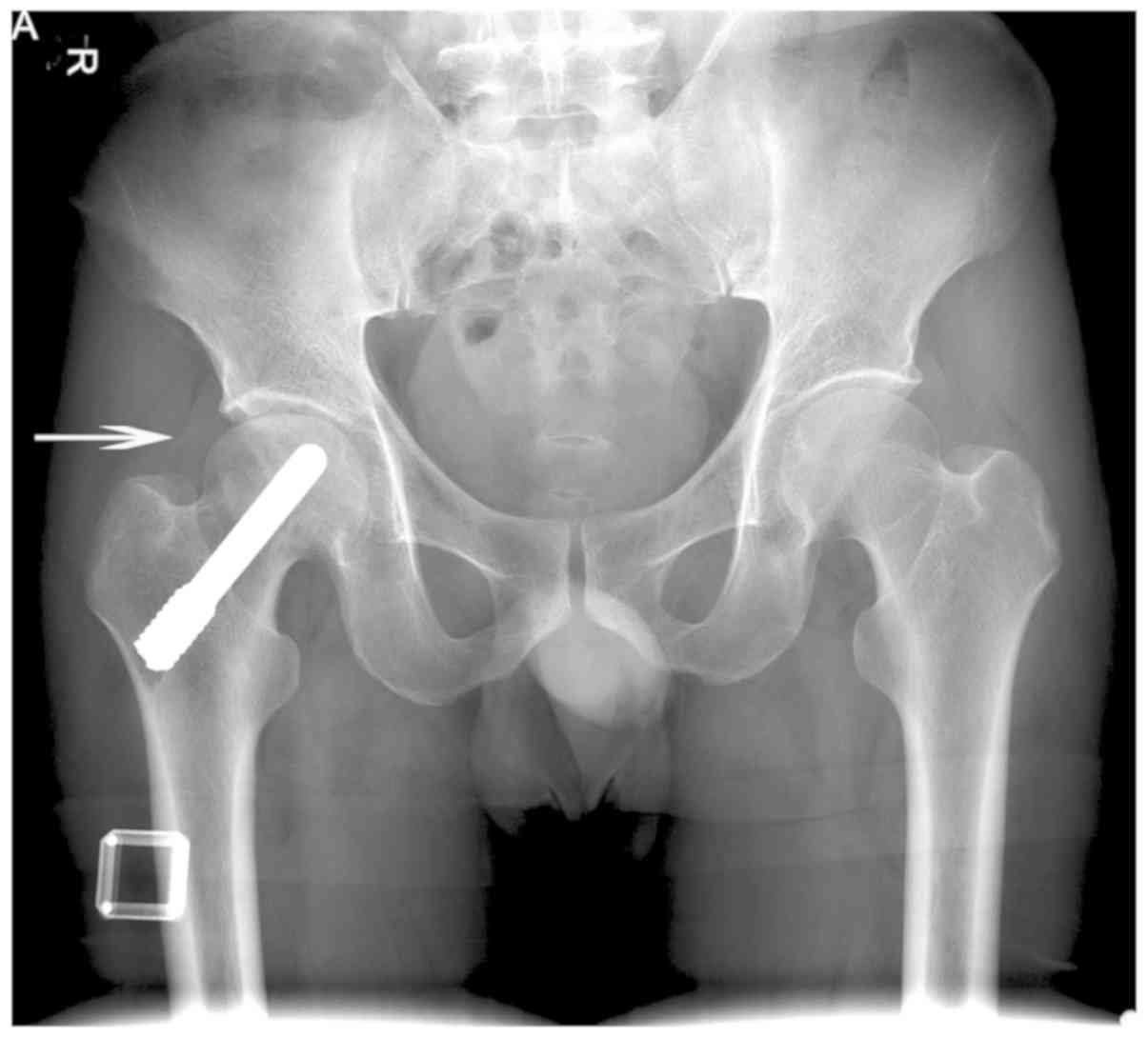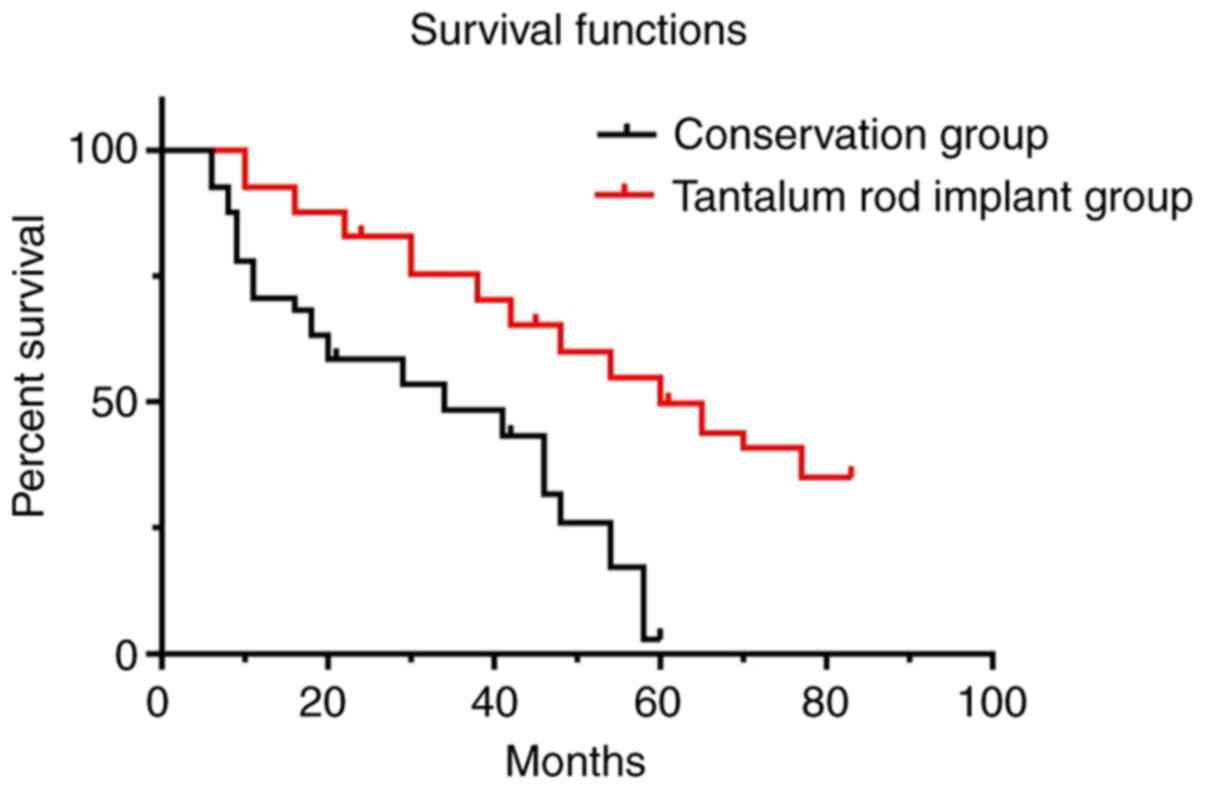|
1
|
Babis GC, Sakellariou V, Parvizi J and
Soucacos P: Osteonecrosis of the femoral head. Orthopedics.
34(39)2011.PubMed/NCBI View Article : Google Scholar
|
|
2
|
Mont MA, Jones LC and Hungerford DS:
Nontraumatic osteonecrosis of the femoral head: Ten years later. J
Bone Joint Surg Am. 88:1117–1132. 2006.PubMed/NCBI View Article : Google Scholar
|
|
3
|
Amanatullah DF, Strauss EJ and Di Cesare
PE: Current management options for osteonecrosis of the femoral
head: Part II, operative management. Am J Orthop (Belle Mead NJ).
40:E216–E225. 2011.PubMed/NCBI
|
|
4
|
Rajpura A, Wright AC and Board TN: Medical
management of osteonecrosis of the hip: A review. Hip Int.
21:385–392. 2011.PubMed/NCBI View Article : Google Scholar
|
|
5
|
Malizos KN, Karantanas AH, Varitimidis SE,
Dailiana ZH, Bargiotas K and Maris T: Osteonecrosis of the femoral
head: Etiology, imaging and treatment. Eur J Radiol. 63:16–28.
2007.PubMed/NCBI View Article : Google Scholar
|
|
6
|
Tripathy SK, Goyal T and Sen RK:
Management of femoral head osteonecrosis: Current concepts. Indian
J Orthop. 49:28–45. 2015.PubMed/NCBI View Article : Google Scholar
|
|
7
|
Jones CA and Pohar S: Health-Related
quality of life after total joint arthroplasty: A scoping review.
Clin Geriatr Med. 28:395–429. 2012.PubMed/NCBI View Article : Google Scholar
|
|
8
|
Lee GW, Park KS, Kim DY, Lee YM,
Eshnazarov KE and Yoon TR: Results of total hip arthroplasty after
core decompression with tantalum rod for osteonecrosis of the
femoral head. Clin Orthop Surg. 8:38–44. 2016.PubMed/NCBI View Article : Google Scholar
|
|
9
|
Zhang X, Wang J, Xiao J and Shi Z: Early
failures of porous tantalum osteonecrosis implants: A case series
with retrieval analysis. Int Orthop. 40:1827–1834. 2016.PubMed/NCBI View Article : Google Scholar
|
|
10
|
Fernandez-Fairen M, Murcia A, Iglesias R,
Sevilla P, Manero JM and Gil FJ: Analysis of tantalum implants used
for avascular necrosis of the femoral head: A review of five
retrieved specimens. J Appl Biomater Funct Mater. 10:29–36.
2012.PubMed/NCBI View Article : Google Scholar
|
|
11
|
Floerkemeier T, Thorey F, Daentzer D,
Lerch M, Klages P, Windhagen H and von Lewinski G: Clinical and
radiological outcome of the treatment of osteonecrosis of the
femoral head using the osteonecrosis intervention implant. Int
Orthop. 35:489–495. 2011.PubMed/NCBI View Article : Google Scholar
|
|
12
|
Liu G, Wang J, Yang S, Xu W, Ye S and Xia
T: Effect of a porous tantalum rod on early and intermediate stages
of necrosis of the femoral head. Biomed Mater.
5(065003)2010.PubMed/NCBI View Article : Google Scholar
|
|
13
|
Nadeau M, Seguin C, Theodoropoulos JS and
Harvey EJ: Short term clinical outcome of a porous tantalum implant
for the treatment of advanced osteonecrosis of the femoral head.
Mcgill J Med. 10:4–10. 2007.PubMed/NCBI
|
|
14
|
Schmitt-Sody M, Kirchhoff C, Mayer W,
Goebel M and Jansson V: Avascular necrosis of the femoral head:
Inter- and intraobserver variations of ficat and ARCO
classifications. Int Orthop. 32:283–287. 2008.PubMed/NCBI View Article : Google Scholar
|
|
15
|
Jawad MU, Haleem AA and Scully SP: In
brief: Ficat classification: Avascular necrosis of the femoral
head. Clin Orthop Relat Res. 470:2636–2639. 2012.PubMed/NCBI View Article : Google Scholar
|
|
16
|
Ovre S, Sandvik L, Madsen JE and Roise O:
Comparison of distribution, agreement and correlation between the
original and modified merle d'Aubigne-Postel score and the harris
hip score after acetabular fracture treatment: Moderate agreement,
high ceiling effect and excellent correlation in 450 patients. Acta
Orthop. 76:796–802. 2005.PubMed/NCBI View Article : Google Scholar
|
|
17
|
Lieberman JR, Engstrom SM, Meneghini RM
and SooHoo NF: Which factors influence preservation of the
osteonecrotic femoral head? Clin Orthop Relat Res. 470:525–534.
2012.PubMed/NCBI View Article : Google Scholar
|
|
18
|
Zalavras CG and Lieberman JR:
Osteonecrosis of the femoral head: Evaluation and treatment. J Am
Acad Orthop Surg. 22:455–464. 2014.PubMed/NCBI View Article : Google Scholar
|
|
19
|
Microsurgery Department of the Orthopedics
Branch of the Chinese Medical Doctor Association, Group from the
Osteonecrosis, Bone Defect Branch of the Chinese Association of
Reparative, Reconstructive Surgery, Microsurgery and Reconstructive
Surgery Group of the Orthopedics Branch of the Chinese Medical
Association: Chinese guideline for the diagnosis and treatment of
osteonecrosis of the femoral head in adults. Orthop Surg 9: 3-12,
2017.
|
|
20
|
Lavernia CJ and Sierra RJ: Core
decompression in atraumatic osteonecrosis of the hip. J
Arthroplasty. 15:171–178. 2000.PubMed/NCBI View Article : Google Scholar
|
|
21
|
Lv H, Zhang L, Yang F, Zhao Z, Yao Q,
Zhang L and Tang P: Comparison of microstructural and mechanical
properties of trabeculae in femoral head from osteoporosis patients
with and without cartilage lesions: A case-control study. BMC
Musculoskelet Disord. 16(72)2015.PubMed/NCBI View Article : Google Scholar
|
|
22
|
Aldridge JM III, Berend KR, Gunneson EE
and Urbaniak JR: Free vascularized fibular grafting for the
treatment of postcollapse osteonecrosis of the femoral head.
Surgical technique. J Bone Joint Surg Am. 86:87–101.
2004.PubMed/NCBI View Article : Google Scholar
|
|
23
|
Wang BL, Sun W, Shi ZC, Zhang NF, Yue DB,
Guo WS, Shi SH and Li ZR: Treatment of nontraumatic osteonecrosis
of the femoral head using bone impaction grafting through a femoral
neck window. Int Orthopaedics. 34:635–639. 2010.PubMed/NCBI View Article : Google Scholar
|
|
24
|
Tsao AK, Roberson JR, Christie MJ, Dore
DD, Heck DA, Robertson DD and Poggie RA: Biomechanical and clinical
evaluations of a porous tantalum implant for the treatment of
early-stage osteonecrosis. J Bone Joint Surg Am. 87:22–27.
2005.PubMed/NCBI View Article : Google Scholar
|
|
25
|
Veillette CJ, Mehdian H, Schemitsch EH and
McKee MD: Survivorship analysis and radiographic outcome following
tantalum rod insertion for osteonecrosis of the femoral head. J
Bone Joint Surg Am. 88:48–55. 2006.PubMed/NCBI View Article : Google Scholar
|
|
26
|
Plakseychuk AY, Shah M, Varitimidis SE,
Rubash HE and Sotereanos D: Classification of osteonecrosis of the
femoral head. Reliability, reproducibility, and prognostic value.
Clin Orthop Relat Res. 386:34–41. 2001.PubMed/NCBI View Article : Google Scholar
|
|
27
|
Shuler MS, Rooks MD and Roberson JR:
Porous tantalum implant in early osteonecrosis of the hip:
Preliminary report on operative, survival, and outcomes results. J
Arthroplasty. 22:26–31. 2007.PubMed/NCBI View Article : Google Scholar
|
|
28
|
Zhao D, Liu B, Wang B, Yang L, Xie H,
Huang S, Zhang Y and Wei X: Autologous bone marrow mesenchymal stem
cells associated with tantalum rod implantation and vascularized
iliac grafting for the treatment of end-stage osteonecrosis of the
femoral head. Biomed Res Int. 2015(240506)2015.PubMed/NCBI View Article : Google Scholar
|
|
29
|
Shi J, Chen J, Wu J, Chen F, Huang G, Wang
Z, Zhao G, Wei Y and Wang S: Evaluation of the 3D finite element
method using a tantalum rod for osteonecrosis of the femoral head.
Med Sci Monit. 20:2556–2564. 2014.PubMed/NCBI View Article : Google Scholar
|
|
30
|
Zhang Y, Li L, Shi ZJ, Wang J and Li ZH:
Porous tantalum rod implant is an effective and safe choice for
early-stage femoral head necrosis: A meta-analysis of clinical
trials. Eur J Orthop Surg Traumatol. 23:211–217. 2013.PubMed/NCBI View Article : Google Scholar
|
|
31
|
Wang C, Meng H, Wang Y, Zhao B, Zhao C,
Sun W, Zhu Y, Han B, Yuan X, Liu R, et al: Analysis of early stage
osteonecrosis of the human femoral head and the mechanism of
femoral head collapse. Int J Biol Sci. 14:156–164. 2018.PubMed/NCBI View Article : Google Scholar
|
|
32
|
Liu Y, Zhao D, Wang W, Zhang Y, Wang B and
Li Z: Efficacy of core decompression for treatment of canine
femoral head osteonecrosis induced by arterial ischaemia and venous
congestion. Hip Int. 27:406–411. 2017.PubMed/NCBI View Article : Google Scholar
|
|
33
|
Castro FP Jr and Barrack RL: Core
decompression and conservative treatment for avascular necrosis of
the femoral head: A meta-analysis. Am J Orthop (Belle Mead NJ).
29:187–194. 2000.PubMed/NCBI
|
|
34
|
Arbab D and Konig DP: Atraumatic femoral
head necrosis in adults. Dtsch Arztebl Int. 113:31–38.
2016.PubMed/NCBI View Article : Google Scholar
|
|
35
|
Miao H, Ye D, Liang W and Yao Y: Effect of
osteonecrosis intervention rod versus core decompression using
multiple small drill holes on early stages of necrosis of the
femoral head: A prospective study on a series of 60 patients with a
minimum 1 year-follow-up. Open Orthop J. 9:179–184. 2015.PubMed/NCBI View Article : Google Scholar
|
|
36
|
Liu Y, Su X, Zhou S, Wang L, Wang C and
Liu S: A modified porous tantalum implant technique for
osteonecrosis of the femoral head: Survivorship analysis and
prognostic factors for radiographic progression and conversion to
total hip arthroplasty. Int J Clin Exp Med. 8:1918–1930.
2015.PubMed/NCBI
|
|
37
|
Mao Q, Wang W, Xu T, Zhang S, Xiao L, Chen
D, Jin H and Tong P: Combination treatment of biomechanical support
and targeted intra-arterial infusion of peripheral blood stem cells
mobilized by granulocyte-colony stimulating factor for the
osteonecrosis of the femoral head: A randomized controlled clinical
trial. J Bone Miner Res. 30:647–656. 2015.PubMed/NCBI View Article : Google Scholar
|
|
38
|
Huang X, Jiang H, Liu D, Zhou Z and Wang
L: Implantation of calcium phosphate cement/danshen drug delivery
system for avascular necrosis of femoral head. Zhongguo Xiu Fu
Chong Jian Wai Ke Za Zhi. 22:307–310. 2008.PubMed/NCBI(In Chinese).
|
|
39
|
Jiang HJ, Huang XJ, Tan YC, Liu DZ and
Wang L: Core decompression and implantation of calcium phosphate
cement/danshen drug delivery system for treating ischemic necrosis
of femoral head at Stages I, II and III of antigen reactive cell
opsonization. Chin J Traumatol. 12:285–290. 2009.PubMed/NCBI
|
|
40
|
Fan Y, Tang L and He W: Clinical study on
the interventional treatment of non-traumatic femoral head mecrosis
by integrated traditional Chinese and western medicine. Zhongguo
Zhong Xi Yi Jie He Za Zhi. 19:605–606. 1999.PubMed/NCBI(In Chinese).
|
|
41
|
Jiang Y, Liu C, Chen W, Wang H, Wang C and
Lin N: Tetramethylpyrazine enhances vascularization and prevents
osteonecrosis in steroid-treated rats. Biomed Res Int.
2015(315850)2015.PubMed/NCBI View Article : Google Scholar
|
|
42
|
Zheng SD and Wu HJ: Progress of studies on
effects of ligustrazine on blood vessel endothelium protection.
Zhongguo Zhong Xi Yi Jie He Za Zhi. 31:1004–1008. 2011.PubMed/NCBI(In Chinese).
|
|
43
|
Liu Y, Yan L, Zhou S, Su X, Cao Y, Wang C
and Liu S: Tantalum rod implantation for femoral head
osteonecrosis: Survivorship analysis and determination of
prognostic factors for total hip arthroplasty. Int Orthop.
40:1397–1407. 2016.PubMed/NCBI View Article : Google Scholar
|
|
44
|
Olsen M, Lewis PM, Morrison Z, McKee MD,
Waddell JP and Schemitsch EH: Total hip arthroplasty following
failure of core decompression and tantalum rod implantation. Bone
Joint J. 98:1175–1179. 2016.PubMed/NCBI View Article : Google Scholar
|
|
45
|
Cheng Q, Tang JL, Gu JJ, Guo KJ, Guo WS,
Wang BL and Zhao FC: Total hip arthroplasty following failure of
tantalum rod implantation for osteonecrosis of the femoral head
with 5- to 10 year follow-up. BMC Musculoskelet Disord.
19(289)2018.PubMed/NCBI View Article : Google Scholar
|

















